Tuskegee Airmen
During World War II, the Tuskegee Airmen were the first African-American military aviators in the United States armed Forces. The American military was racially segregated, as was much of the federal govenment. Racial discrimination was subjected upon the Tuskegee Airmen both within and outside of the army. Dispite these adversities, the Tuskegee Airmen, trained and flew with distinction and pride.
Formally they formed the 332nd Fighter Group and the 477th Bombardment Group of the U.S. Army Air Corps. Although the 477th Bombardment Group trained and flew the North American B-25 Mitchell bombers, they were never sent overseas into combat; the Tuskegee 332nd Fighter Group was the only operational unit, first sent overseas as part of "Operation Torch", in North Africa... then seeing action over Sicily and Italy, before being deployed as bomber escorts in Europe... where they served with pride and distinction, and were very successful in that area of operation.
The Tuskegee Airmen were initially equipped with the Curtis P-40 Warhawks fighter-bomber, briefly with the Bell P-39 airacobras (March 1944), later they were given the Republic P-47 Thunderbolts (June through July 1944), and finally, in July 1944, the 332nd Fighter Group was given the North American P-51 Mustang to which the Tuskegee Airmen are commonly associated with.
In June and July of 1944, the 332nd Fighter Group, painted all their aircraft tails a crimson red, and the nickname "Red Tails" was coined. The bomber crews applied a more effusive "Red-Tail Angels" to the legendary group.
There are four squadrons that make up the 332nd Fighter Group; the first was the 99th Fighter squadron, which was the first squadron of the 332nd to be deployed overseas for combat duty, to North Africa, on April 1943, where they would join the 33rd Fighter Group. The 99th's assignment was predominantly a ground attack role, which prevented the 99th from engaging in air-to-air combat. On June of 1943, the 99th squadron moved to Sicily and continued operations there, receiving a Distinguished Unit Citation for it's performance in combat.
The rest of the 332nd Fighter Group arrived in Italy,in the early spring of 1944, under the command of Colonel Benjamin O. Davis Jr. He brought with him, three new combat ready squadrons to Italy... the 100th, the 301st and the 302nd Fighter Squadrons. The 99th Fighter Squadron was reassigned back to the 332nd shortly thereafter. The 332nd Fighter Group, was now finally at full combat strength!
The 332nd's new home was Ramitelli Airfield, near Termoli, on the Adriatic coast. From this base the 332nd Fighter Group escorted the Fifteenth Air Force Heavy bombers, to and from raids, into Czechoslovakia, Austria, Hungary, Poland, and Germany. The Tuskegee Airmen of the 332nd Fighter Group, not only flying escort for the heavy bombers, but many ground attack missions as well, earned the "Red Tails" a very impressive combat record, including over 1000 awards and decorations!
Formally they formed the 332nd Fighter Group and the 477th Bombardment Group of the U.S. Army Air Corps. Although the 477th Bombardment Group trained and flew the North American B-25 Mitchell bombers, they were never sent overseas into combat; the Tuskegee 332nd Fighter Group was the only operational unit, first sent overseas as part of "Operation Torch", in North Africa... then seeing action over Sicily and Italy, before being deployed as bomber escorts in Europe... where they served with pride and distinction, and were very successful in that area of operation.
The Tuskegee Airmen were initially equipped with the Curtis P-40 Warhawks fighter-bomber, briefly with the Bell P-39 airacobras (March 1944), later they were given the Republic P-47 Thunderbolts (June through July 1944), and finally, in July 1944, the 332nd Fighter Group was given the North American P-51 Mustang to which the Tuskegee Airmen are commonly associated with.
In June and July of 1944, the 332nd Fighter Group, painted all their aircraft tails a crimson red, and the nickname "Red Tails" was coined. The bomber crews applied a more effusive "Red-Tail Angels" to the legendary group.
There are four squadrons that make up the 332nd Fighter Group; the first was the 99th Fighter squadron, which was the first squadron of the 332nd to be deployed overseas for combat duty, to North Africa, on April 1943, where they would join the 33rd Fighter Group. The 99th's assignment was predominantly a ground attack role, which prevented the 99th from engaging in air-to-air combat. On June of 1943, the 99th squadron moved to Sicily and continued operations there, receiving a Distinguished Unit Citation for it's performance in combat.
The rest of the 332nd Fighter Group arrived in Italy,in the early spring of 1944, under the command of Colonel Benjamin O. Davis Jr. He brought with him, three new combat ready squadrons to Italy... the 100th, the 301st and the 302nd Fighter Squadrons. The 99th Fighter Squadron was reassigned back to the 332nd shortly thereafter. The 332nd Fighter Group, was now finally at full combat strength!
The 332nd's new home was Ramitelli Airfield, near Termoli, on the Adriatic coast. From this base the 332nd Fighter Group escorted the Fifteenth Air Force Heavy bombers, to and from raids, into Czechoslovakia, Austria, Hungary, Poland, and Germany. The Tuskegee Airmen of the 332nd Fighter Group, not only flying escort for the heavy bombers, but many ground attack missions as well, earned the "Red Tails" a very impressive combat record, including over 1000 awards and decorations!
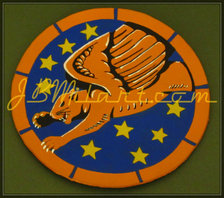
99th Fighter Squadron, 332nd Fighter Group, 12th and 15th Army Air Force, MTO.
The first of the Tuskegee fighter squadrons to see combat in WWII. Shipped out of Tuskegee with their Curtis P-40's, on 2 April 1943, bound for North Africa, where it would join the 33rd Fighter Group and it's commander, Colonel William W. Momyer. The 99th's first combat mission was to attack the small strategic volcanic island of Pantelleria in the Mediterranean Sea to clear the sea lanes for the Allied invasion of Sicily in July 1943. The air assault on the island began on 30 May 1943. the 99th flew it's first combat mission the following month. The 99th was restricted to ground attacks only, until the rest of the 332nd Fighter Group arrived in Italy in spring of 1944. The 99th continued to fly ground attack missions... earning a Distinguished Unit Citation for it's outstanding performance in combat. This patch is 5 inches in diameter.
The first of the Tuskegee fighter squadrons to see combat in WWII. Shipped out of Tuskegee with their Curtis P-40's, on 2 April 1943, bound for North Africa, where it would join the 33rd Fighter Group and it's commander, Colonel William W. Momyer. The 99th's first combat mission was to attack the small strategic volcanic island of Pantelleria in the Mediterranean Sea to clear the sea lanes for the Allied invasion of Sicily in July 1943. The air assault on the island began on 30 May 1943. the 99th flew it's first combat mission the following month. The 99th was restricted to ground attacks only, until the rest of the 332nd Fighter Group arrived in Italy in spring of 1944. The 99th continued to fly ground attack missions... earning a Distinguished Unit Citation for it's outstanding performance in combat. This patch is 5 inches in diameter.
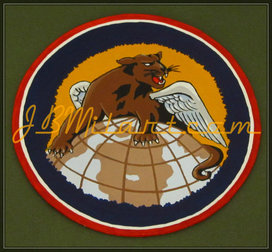
100th Fighter Squadron, 332nd Fighter Group, 12th and 15th Army Air Force, MTO.
The second of the Tuskegee fighter squadrons. Combat training began in late March 1943, at Selfridge Field, Michigan. There it received sufficient personnel to fill out the next three squadrons, 100th, 301st, and the 302nd Fighter Squadrons for operational training with P-39 and P-40 aircraft. The three squadrons completed training in December 1943 and prepared to ship overseas. The squadrons sailed in early January 1944 and arrived in Italy in early February 1944, becoming part of the 12th Air Force, MTO. The 100th flew it's first combat mission on 19 February 1944. The 100th flew missions such as ground attack, strafing, rescue, convoy escort, reconnaissance, until May 1944 when the 100th was reassigned to the 15th Air Force, for primary escort duty for the heavy bombers, striking Germany's industrial and military targets. Patch is 5 inches in diameter.
The second of the Tuskegee fighter squadrons. Combat training began in late March 1943, at Selfridge Field, Michigan. There it received sufficient personnel to fill out the next three squadrons, 100th, 301st, and the 302nd Fighter Squadrons for operational training with P-39 and P-40 aircraft. The three squadrons completed training in December 1943 and prepared to ship overseas. The squadrons sailed in early January 1944 and arrived in Italy in early February 1944, becoming part of the 12th Air Force, MTO. The 100th flew it's first combat mission on 19 February 1944. The 100th flew missions such as ground attack, strafing, rescue, convoy escort, reconnaissance, until May 1944 when the 100th was reassigned to the 15th Air Force, for primary escort duty for the heavy bombers, striking Germany's industrial and military targets. Patch is 5 inches in diameter.
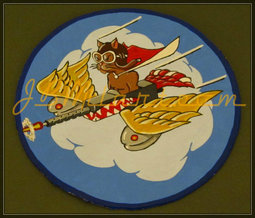
301st Fighter Squadron, 332nd Fighter Group, 12th and 15th Army Air Force, MTO.
The third of the Tuskegee fighter squadrons. After arriving in Italy with the other squadrons in February 1944, the 332nd Fighter Group excelled in targets of opportunity. Flying in P-39 and P-47 aircraft, the squadrons threw themselves at the enemy. Knocking out trains, bridges, airdromes, troop concentrations, communication lines, and enemy aircraft. In June of 1944 the squadrons received the P-51 Mustangs, and continued their ground attacks until August 1944, the 332nd Fighter Group was reassigned to the 15th Air Force, for escort duties. The 15th heavy bombers needed escorts to and from the the targets as the enemy fighters were causing heavy losses to the "Big Friends", before they even reached their targets! The 332nd Fighter Group, for their escort mission to Berlin on 23 March 1945, was awarded the Distinguished Unit Citiation, for fighting off a large formation of enemy fighters, including jets, from the bombers, to complete their mission. The patch is 5 inches in diameter.
The third of the Tuskegee fighter squadrons. After arriving in Italy with the other squadrons in February 1944, the 332nd Fighter Group excelled in targets of opportunity. Flying in P-39 and P-47 aircraft, the squadrons threw themselves at the enemy. Knocking out trains, bridges, airdromes, troop concentrations, communication lines, and enemy aircraft. In June of 1944 the squadrons received the P-51 Mustangs, and continued their ground attacks until August 1944, the 332nd Fighter Group was reassigned to the 15th Air Force, for escort duties. The 15th heavy bombers needed escorts to and from the the targets as the enemy fighters were causing heavy losses to the "Big Friends", before they even reached their targets! The 332nd Fighter Group, for their escort mission to Berlin on 23 March 1945, was awarded the Distinguished Unit Citiation, for fighting off a large formation of enemy fighters, including jets, from the bombers, to complete their mission. The patch is 5 inches in diameter.
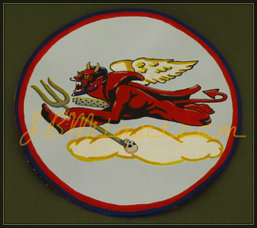
302nd Fighter Squadron, 332nd Fighter Group, 12th and 15th Army Air Force, MTO.
This is the fourth and last of the Tuskegee fighter squadrons. The 302nd Fighter Squadron, and the rest of the 332nd Fighter Group, throughout the entire war, was an exceptional group of Americans. Who answered the call to duty. To help protect the rights of others, for their freedom and liberties around the world. For the respect, of not only from their enemies, (which they got)... but from their fellow countrymen... who can finally say to these men... who put their lives on the line... job well done!
This patch is 5 inches in diameter.
This is the fourth and last of the Tuskegee fighter squadrons. The 302nd Fighter Squadron, and the rest of the 332nd Fighter Group, throughout the entire war, was an exceptional group of Americans. Who answered the call to duty. To help protect the rights of others, for their freedom and liberties around the world. For the respect, of not only from their enemies, (which they got)... but from their fellow countrymen... who can finally say to these men... who put their lives on the line... job well done!
This patch is 5 inches in diameter.
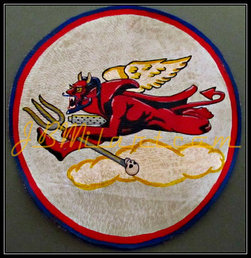
302nd Fighter Squadron, 332nd Fighter Group... Tuskegee Airmen distressed weathered patch.
This weathered patch is for those who want their new patch to look like it's 60 years old... without waiting years to get it that way...
Contact jbmilart or a2jacketpatches for information on weathered patches of your choice...
This weathered patch is for those who want their new patch to look like it's 60 years old... without waiting years to get it that way...
Contact jbmilart or a2jacketpatches for information on weathered patches of your choice...
477th Bombardment Group (Medium)
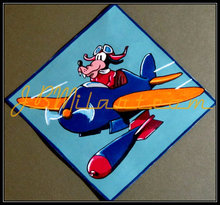
616th Bombardment Squadron (Medium), 477th Bombardment Group, 3rd and 1st Army Air Force, American Theater.
Established on 13 May 1943. Activated on 1 June 1943. Assigned to the 3rd Air Force, the 477th Bombardment Group was a training group for the B-26 Marauder, until 15 January 1944 when the group started training in the B-25 Mitchell. The group was then redesignated, the 477th Composite Group. The group's main duties were the training of replacement crews for combat in the B-25 and B-26 medium bombers.
Stations: MacDill Field, Fla, 1 June to 25 August 1943. Selfridge Field, Mich, 15 January 1944; Godman Field, Ky, 6 May 1944; Lockbourne AAB, Ohio, 13 March 1946 to 1 July 1947... when the 477th was deactivated.
The 616th Bombardment Patch size: 5 inches x 5 inches.
Established on 13 May 1943. Activated on 1 June 1943. Assigned to the 3rd Air Force, the 477th Bombardment Group was a training group for the B-26 Marauder, until 15 January 1944 when the group started training in the B-25 Mitchell. The group was then redesignated, the 477th Composite Group. The group's main duties were the training of replacement crews for combat in the B-25 and B-26 medium bombers.
Stations: MacDill Field, Fla, 1 June to 25 August 1943. Selfridge Field, Mich, 15 January 1944; Godman Field, Ky, 6 May 1944; Lockbourne AAB, Ohio, 13 March 1946 to 1 July 1947... when the 477th was deactivated.
The 616th Bombardment Patch size: 5 inches x 5 inches.
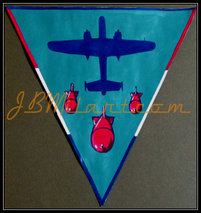
617th Bombardment Squadron (Medium), 477th Bombardment Group, 3rd and 1st Army Air Force, American Theater.
617th Bombardment Patch size: 5 inches x 4 3/4 inches.
617th Bombardment Patch size: 5 inches x 4 3/4 inches.
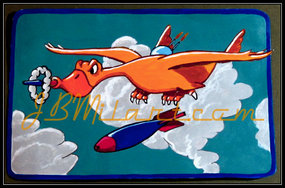
618th Bombardment Squadron (Medium), 477th Bombardment Group, 3rd and 1st Army Air Force, American Theater.
618th Bombardment Patch size: 5 inches x 3 3/8 inches.
618th Bombardment Patch size: 5 inches x 3 3/8 inches.
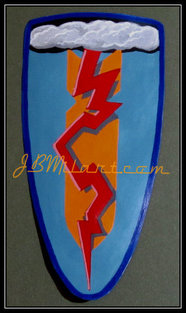
619th Bombardment Squadron (Medium), 477th Bombardment Group, 3rd and 1st Army Air Force, American Theater.
619th Bombardment Patch size: 2 1/2 inches x 5 1/4 inches.
619th Bombardment Patch size: 2 1/2 inches x 5 1/4 inches.
Jim was commissioned by the NGAnet VTC (photo recon) in St. Louis, Mo. To help them with a dedication conference room there at the AFB in St. Louis, in honor of the Tuskegee Airmen, in particular Captain Wendell Oliver Pruitt, who was from the St. Louis area, and was a Tuskegee Airman fighter pilot.
Jim painted the patches for the Tuskegee Airmen's 332nd Fighter Group and the 477th (Medium) Training Bomber Group squadron patches... and is honored to have his patch paintings, amoungst the WWII photos of the heros of the Tuskegee Airmen...
Jim painted the patches for the Tuskegee Airmen's 332nd Fighter Group and the 477th (Medium) Training Bomber Group squadron patches... and is honored to have his patch paintings, amoungst the WWII photos of the heros of the Tuskegee Airmen...